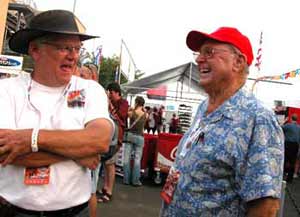| 
Chrisman Is The King
3/8/05
Art Chrisman is amazing. Half a century ago, he made the
first pass at the inaugural NHRA Nationals in a converted
dry-lakes car he towed from California to Great Bend, Kansas.
Twenty-five years ago, the same car and driver celebrated
the Big Go’s silver anniversary by making a lap that
lit up IRP’s scoreboards with a reading of 95 mph —
despite “safety gear” consisting of a baseball
cap and T-shirt.
 |
| A member of “five or six”
motorsports halls of fame, Art Chrisman continues to drive
supercharged slingshots at age 75. Shown bench-racing
with longtime-fan Buzz Baylis at Indy, Chrisman also built
and tunes the mouse motor in his son’s 7.1-second,
188-mph Junior Fueler. (Good Communications photo by Dave
Wallace, ©2004) |
Last September, at age 75, Chrisman and “Number 25”
opened pro qualifying for Indy’s 50th-annual celebration,
following a ribbon-cutting ceremony featuring the mayor of
Indianapolis.
This time, the old guy in the baseball hat took it easy in
his 70-year-old race car — to the great relief of officials
who never know what to expect from one of drag racing’s
greatest thinkers, innovators and drivers.
Among other accomplishments numerous enough to fill up his
own history book, Chrisman was among the first to master the
top-mounted GMC supercharger.
With the help of Leonard Simmons’ Windjammer Blower
Service, he successfully switched from a crank-mounted system
in time to win the inaugural U.S. Fuel and Gas Championships
in 1959, driving the original Hustler slingshot. By that time,
Art had already secured future membership in any hall of fame
that would be worth entering, including the International
Drag Racing Hall Of Fame (Ocala, Fla.) and the Motorsports
Hall Of Fame (Novi, Mich.).
Chrisman had been driving dragsters since 1950, when he brought
his converted dry-lakes car to the Santa Ana, Calif., airport
runway that C.J. Hart had turned into the world’s first
commercial drag strip.
In 1953, this flathead-powered “rail job” broke
drag racing’s 140-mph barrier. A year earlier, Art had
become one of the first five Bonneville racers to exceed 200
mph (even before the prestigious “Two Club” had
been conceived).
Ironically, one of Chrisman’s most-significant contributions
is also among the most-overlooked: His unintentional role
in supercharging the fledging nostalgia movement.
No one could have predicted the far-reaching impact of Art’s
smoke-filled exhibition runs at both the 1978 March Meet and
the 1979 U.S. Nationals. The resultant national publicity
inspired other oldtimers to drag long-abandoned slingshots
out of barns and backyards. A sport within a sport was born,
and the rest — like so much of Chrisman’s life
— is history.

|
